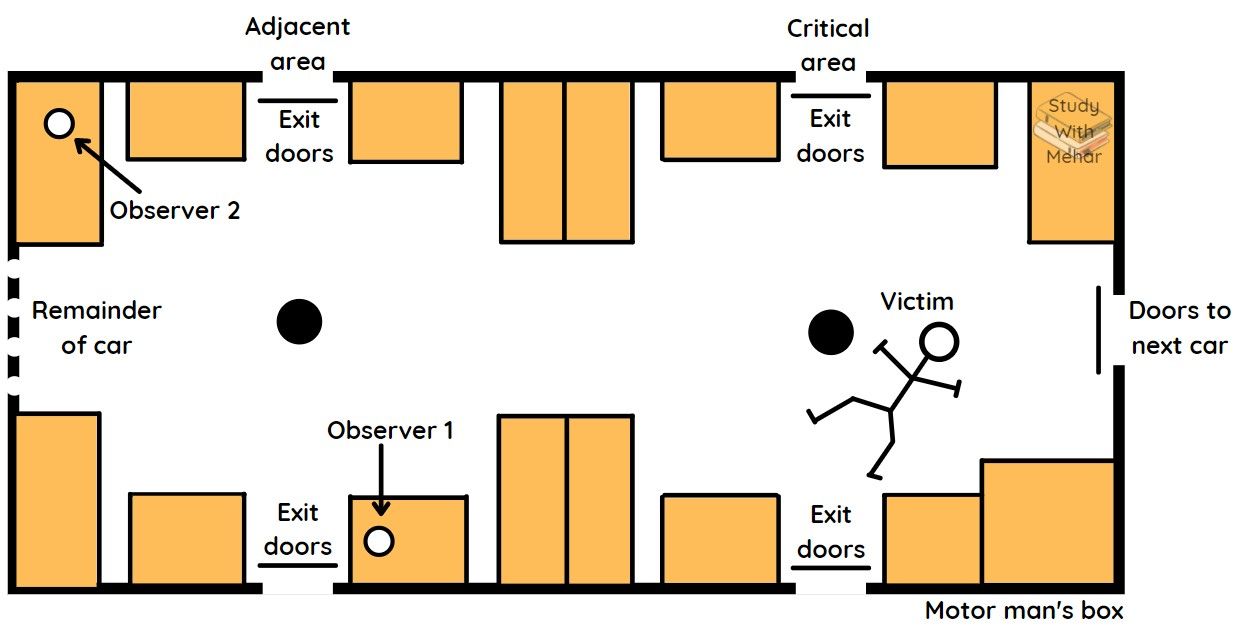Piliavin et al. (1969)
Aim: to investigate bystander behaviour in a natural setting. to investigate the effect of the variables on helping: • type of victim, • race of the victim
Aim: To investigate bystander behaviour in a natural setting.
To investigate the effect of the following variables on helping:
• type of victim
• race of the victim
• model behaviour
• size of bystander group.
Background
Kitty Genovese in 1964, was assaulted near her house. 38 individuals witnessed the case, but they did not do anything to prevent her murder. Darley and Latané (1968) said that the diffusion of responsibility could be a reason. People would be more likely to help if they see a model do so. There is evidence that people will help those who are similar to themselves.
Research Method, Design and Variables
A field experiment in a New York City subway.
The independent groups design as different people were exposed to different models on their journey.
Independent variables:
• type of victim - either drunk or ill
• race of victim - either black or white
• the model behaviour - close or distant proximity and helping early or late.
• size of bystander group (naturally occurring)
Dependent variables:
• time taken for a passenger to help.
• total number of passengers who offered help.
• verbal remarks were also recorded.
Sample
Opportunity sampling was used. The sample consisted of passengers travelling by subway between Harlem and Bronx on weekdays between 11:00 AM and 3:00 PM. The number of passengers was estimated to be 4450 people with 45% being black and 55% being white. There were around 43 passengers per carriage and 8.5 in the critical area.
Procedure
4 teams of student researchers from the University of Columbia carried out the study. On each trial, 2 males and 2 females boarded the train through different doors. Females were observers. The male confederates took the role of the victim and the model.
Observer: Both females were confederates who observed and recorded data. Females sat in the area adjacent to the immediate critical area.
Victim: The victim was played by four different men — 1 black and 3 white people. They were aged 26 - 35 years. They dressed in identical casual clothing — an Eisenhower jacket, old trousers, and no tie. On 38 of 103 trials, the victim smelled of alcohol and carried a bottle of alcohol wrapped in a brown bag. On the other 65 trials, they appeared sober and carried a black cane.
Model: They were white males aged 24 – 29 and were dressed informally. They raised the victim to the sitting position and stayed with him till the next stop.

Scene
Females observed passengers and recorded the race, gender, and location of each helper. The victim stood at the pole at the centre of the critical area. The model remained standing throughout the trial. Each trial used the same route as it included a 7.5-minute gap between 2 stations. At approximately 70 seconds, the victim staggered forward and collapsed. He laid on the floor looking upwards. If he received no help, the model would help him at the next stop. When ‘modelling’ helping, the model helped the victim to a sitting position and stayed with him until the next stop.
Trials were split into 5 conditions:
- Critical/early: the model stood in the critical area and waited 70 seconds to help the victim.
- Critical/late: the model stood in the critical area and waited 150 seconds to help the victim.
- Adjacent/early: the model stood in the adjacent area and waited 70 seconds to help the victim.
- Adjacent/late: the model stood in the adjacent area and waited 150 seconds to help the victim.
- No model condition: the model did not help the victim until after the trial was over and the train reached the next stop.
Results
- The frequency of helping was much higher than previously reported in laboratory studies. The majority of helpers were males.
- 80% of victims received spontaneous help. 60% of victims received help from more than one person. Participants are more likely to help victims with a cane (62/65 trials) than the drunk victim (19/38 trials). spontaneous helping was earlier for cane victims.
- Both black and white cane victims received equal help. In drunk conditions, same-race helping behaviour was found. Black drunk victims received less help overall.
- Early model intervention at 70 seconds slightly received more helping behaviour than waiting till 150 seconds.
- The research does not support the diffusion of responsibility. In fact, 7 person groups responded faster than 3 person groups.
- In 20% of trials, people moved away from the critical area during the incident. A high number of comments during the trials where help wasn’t given was recorded. More comments were recorded during drunk victim trials.
Conclusion
- In a natural setting, many people would offer spontaneous help to a stranger, even in a group situation.
- No diffusion of responsibility was found.
- Factors that may determine the decision to help:
- Type of victim (people with canes are more likely to be helped rather than a drunk victim)
- Gender of helper (men are more likely to offer help)
- Similar race (more help is given to a similar race, especially for drunk victims)
- The longer the emergency continues, the less likely it is for someone to help. They would cope with arousal in other ways.
Strengths and Weaknesses
- It was a field experiment using independent groups design therefore, there was high ecological validity as participants’ behaviour was natural. However, we cannot control extraneous variables that influence behaviour thus, lowering validity and reliability.
- We cannot be sure if participants only took part once. They may suspect a set-up and show demand characteristics by helping more, or less.
- NYC subway sample is not generalizable to the upper class, rural areas, other countries but, as the sample was large it is likely to be representative. The sample included different ethnicities thus, there is representativeness.
- Quantitative measurements were objective as data by the two observers could be cross-checked, thus it is reliable. Qualitative data such as the remarks and behaviour of participants helped understand thoughts and behaviours.
- Ethical Issues: participants did not give informed consent in taking part plus, they were not debriefed. Participants were deceived as they may have thought that the victim genuinely requires help. They may have suffered psychological distress from guilt or concern. Their comments were recorded, and this could be considered a violation of privacy.
Application to Everyday Life
It tells us the specific situational factors that may make bystanders more likely to help such as, same race or same-sex. We can also learn that an individual is more likely to be offered help if they do not intimidate, embarrass, or disgust the helper.
